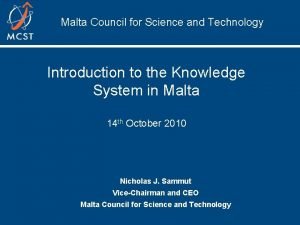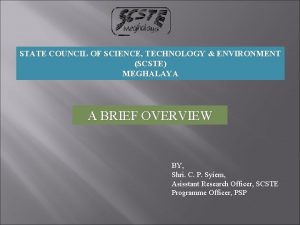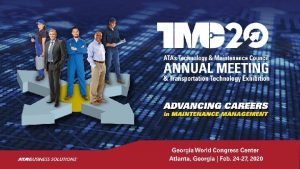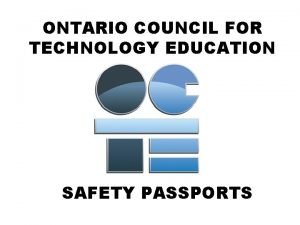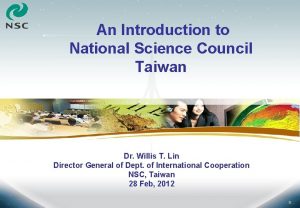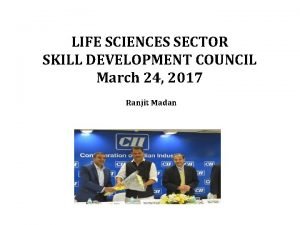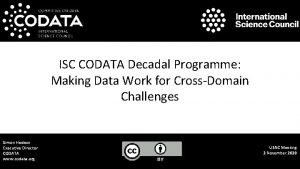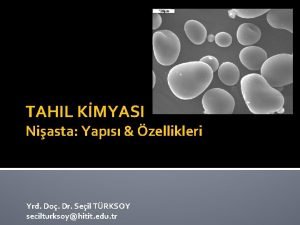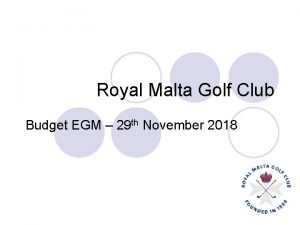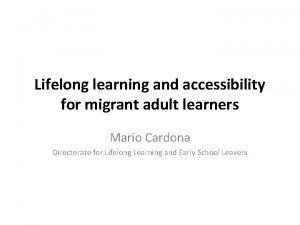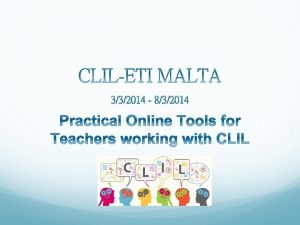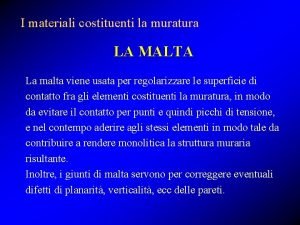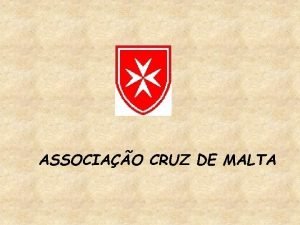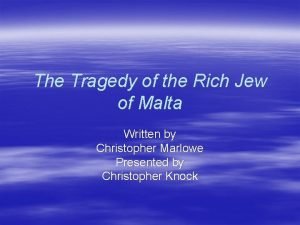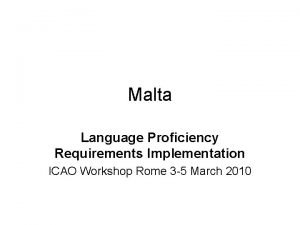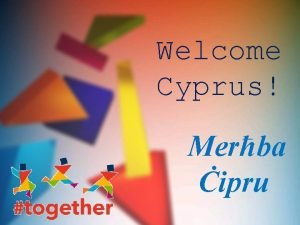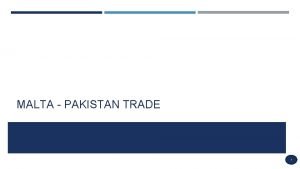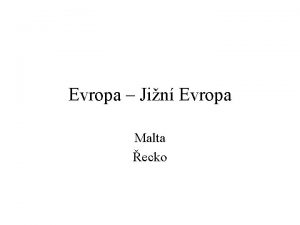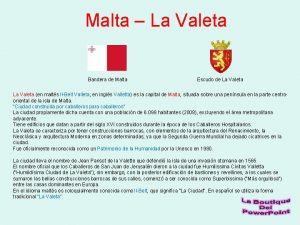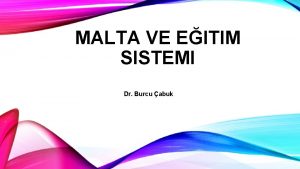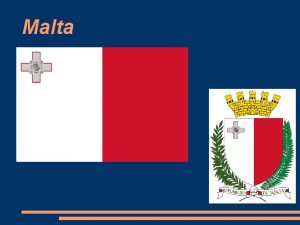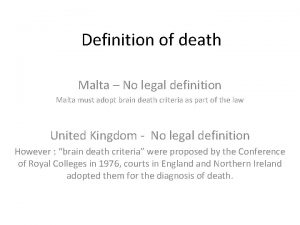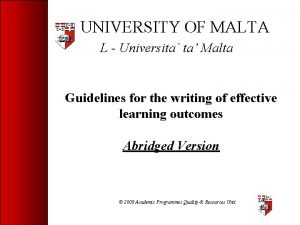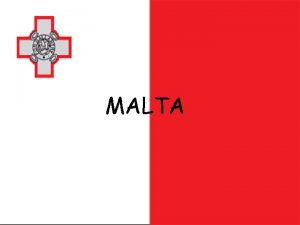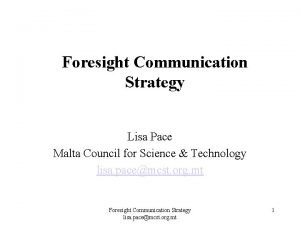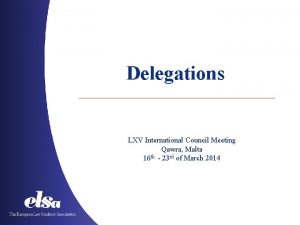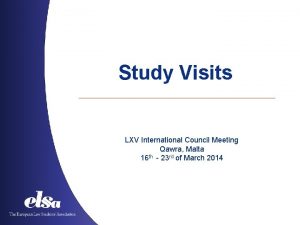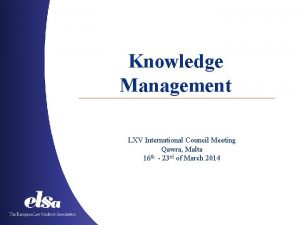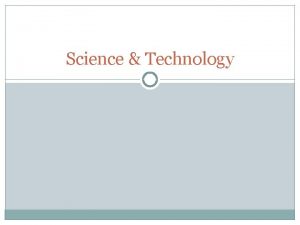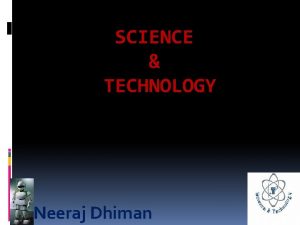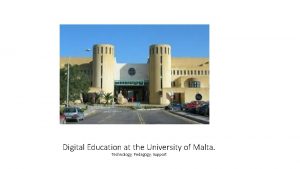Malta Council for Science and Technology Introduction to





























- Slides: 29

Malta Council for Science and Technology Introduction to the Knowledge System in Malta 14 th October 2010 Nicholas J. Sammut Vice-Chairman and CEO Malta Council for Science and Technology

Contents 1. Background to the national landscape for R&I 2. MCST’s areas of activity 3. Overview of statistics 4. Malta and the ERA dimension 2

Contents 3 • Background to the national landscape for R&I • MCST’s areas of activity • Overview of statistics • Malta and the ERA dimension

Characteristics of the national research landscape • Relatively young with traditionally low levels of investment in R&D • Small, open economy characterized by a very high percentage of micro-enterprises. • Most private R&D concentrated in a few firms clustered around specific sectors. • Fragmentation affecting capacity to participate in international research set-ups and capacity to absorb funds locally • Public R&D funding is mostly direct funding. Only a small proportion is distributed through a competitive call. 4

Main public entities involved Ministry Relevant Policy Area Related Entity/ies Office of the Prime Minister Science and Technology, Research and Innovation Malta Council for Science National R&I Funding and Technology Programme, FP. Cohesion Policy Planning and Priorities Coordination Department Higher and Further Education University of Malta (both STEPS a HEI and major research performer) MGSS Ministry of Education, Employment and the Family Instruments ERDF, ESF, Cohesion Fund. RTDI Trust Fund Malta College of Arts, Science and Technology Ministry for Finance, the Economy and Investment Industry Policy SME Policy Malta Enterprise Grants Tax Refunds CIP 5

Contents 1. Background to the national landscape for R&I 2. MCST’s areas of activity 3. Overview of statistics 4. Malta and the ERA dimension 6

MCST Today • Set up in 1988 • Scope: Science, Technology, Research & Innovation • Responsibilities: • 1) National R&I Strategic Plan • 2) EU Policy Initiatives • 3) FP 7 National Contact Organisation • 4) National RTDI Funding Agency • 5) Science Popularisation 7

MCST Team - 13 advisory directors Board of Directors - 8 full timers - 8 part timers CEO -13 full timers being recruited -Total 24 FT + 10 PT Director Strategy, Policy, FP & International Personal Assistant Director RTDI Funds Strategy and Policy Framework Programme RTDI Funds Research Policy Innovation Policy International Cooperation National Coordinator PCM/NCP 1 PCM/NCP 2 PCM/NCP 3 ERDF Manufacturing Platform RTDI Program Manager RTDI Externalisation & Culture Director Projects Interactive Centre Botanical Gardens Administrative Executive (Financial Control, Human Resources, Administration, Maintenance, Premises, Contracts, Administration of FP projects) ESF - Science Popularization Marketing & Events Accountant Accounts Executive Receptionist, PA, Secretary Assistant to Chairman 8

1(a). National R&I Strategic Plan 2007 -2010 • Approved by the Cabinet of Ministers in 2006. • Championed by MCST. 1. Address national issues. 2. Focus on selected areas of economic importance. 3. Enable SMEs to innovate. 4. Export locally-generated R&I. 5. Expand the local SET human capital base. 6. Establish a nexus between industry and academia. 7. Develop a national proinnovation culture which support invention, risk taking and entrepreneurship. • Based on 7 strategic principles • Aims to set up a R&I enabling framework. • Highly business-oriented. • Identified 4 priority research areas for Malta. 9 I. III. IV. Health and biotechnology. ICT Energy and environment. High value-added manufacturing.

1(b). Main ongoing actions to implement the national R&I strategy between 2008 -2010 by key players • Boosting HR in S&T and increasing researcher numbers – STEPS and MGSS schemes. • Approx. € 34 million in new or upgrading of research infrastructure. • € 15 million in a Life Sciences Centre strategically positioned to combine research, innovation and higher education aspects. • Science popularization campaign. • Thematic research strategy for high value added manufacturing. • First steps towards specialization into digital games production and setting up of a national bio-bank. • Grants and tax incentives for industry. • University Trust Fund set up. • Analysis of possible collaboration with international scientific organizations including possible access to research infrastructures. • Awareness raising on the importance of patents. • Amendments to participation rules of the national R&I programme. • Financial support for researchers to participate in brokerage events. 10

2. EU Policy Initiatives - support and national representation • Working Party for Research and Atomic Questions • Competitiveness Council • ERAC (European Research Area Committee) and related groups. • JRC Board of Governors • ESFRI (European Strategy Forum on Research Infrastructures) • Regular liaison with thematic ministries concerning research aspects of their portfolios. 11

3. FP 7 National Contact Organization • Provision of advice and information covering all aspects of FP 7 (including info days, one-toone meetings, etc. ) • National Contact Point (NCP) identified for every thematic and horizontal area. • Every local NCP is part of a NCP network at the European level. 12

Participation in FP 7 Preliminary indications for Malta’s participation in FP 7 are positive from the following aspects: • In the first two years of FP 7, Malta already secured 64 funded projects as compared to a total of 112 for FP 6. • Malta had secured over € 6 million to date as compared to a total of 10 M Euros in FP 6. • A number of new entrants are participating in FP 7 including a substantial number of Malta-based public and private sector participants which have already been successful in FP 6. 13

FP 7 Participation to date (at Dec 09) • Strong performance in ICT and SSH. • Weak performance in ‘Ideas’ and ‘People’. • 64% of budget received so far in FP 7 is from the Cooperation programme. • 32% of budget received is from the Capacities programme. • Success rate for Capacities is higher (21%) than for Cooperation (17%). 14

4. National R&I Programme • Ongoing since 2004 • Aims to build local capacity and collaboration in R&I. • Yearly budget of approx. € 700, 000. • Funds applied research and experimental development on a competitive basis • Proposals to be submitted by consortia made up of both academic and industrial partners. • Foreign researchers can participate but cannot receive funding. 15

5. Science popularisation • Science popularisation strategy developed in 2008. • ESF funded project ‘A science popularization campaign’ (Approx. budget: € 0. 5 million) • Two large-scale one-week science and technology festivals with a strong emphasis on active engagement through handson activities and edutainment. • Six mini-festivals in collaboration with local councils over a larger geographical spread with the intention of increasing community awareness and involvement. • Radio spots, scientific mini-documentaries and a science animation training course. 16

Planned work and activities • Significant boost to HR capacity at MCST. • More active pursuit of collaboration opportunities with major international scientific organizations. • Set up of an interactive science centre/museum. • Thematic R&D strategy development on energy and health. • Follow up R&I Strategy post-2010. • More strategic approach towards FP participation. 17

Contents 1. Background to the national landscape for R&I 2. MCST’s areas of activity 3. Overview of statistics 4. Malta and the ERA dimension 18

R&D Statistics Malta R&D expenditure as a percentage of GDP GERD BERD GOVERD HERD 2004 0. 53 0. 35 0. 01 0. 17 2005 0. 57 0. 38 0. 03 0. 16 2006 0. 61 0. 40 0. 03 0. 18 2007 0. 58(p) 0. 38 0. 02 0. 19 2008 0. 54(p) 0. 35(p) 0. 01 0. 17 Year (p) = provisional Source: Eurostat. Accessed on-line June 4 th 2010. 19

R&I aspects of the 2010 budget • Additional € 4 million for the R&D&I streams of the ’ 20 million for industry’ grant scheme. • € 0. 25 million for the preparation of a national strategy for the development of the digital gaming industry. • € 0. 25 million for the setting up of a national bio-bank. • € 0. 5 million for the setting up of a Malta University Research, Innovation and Development Trust Fund • Tax exemption from royalties and similar revenue resulting from patents on inventions. • 15. 2% refund on expenses on which tax has been paid on research projects. 20

Malta in the Innovation Scoreboard • In the EIS 2009, MT improved its classification from ‘catching up country’ to ‘moderate innovator’. • MT displays the largest improvement within its peer group of moderate innovators. • Above-average improvement in the dimensions of ‘human resources’, ‘firm investments’, ‘linkages and entrepreneurship’, ‘throughputs’ and ‘innovators’. • Below-average investment in ‘finance and support’. 21

Contents 1. Background to the national landscape for R&I 2. MCST’s areas of activity 3. Overview of statistics 4. Malta and the ERA dimension 22

ERA and the National R&I Strategy ERA policy development National policy Development • Ongoing since 2000 but revamped • in 2007 with the ERA Green Paper. • • Six priority areas of European importance. • • Overarching policy approach which is not always sensitive to size considerations. • Touches upon many priority areas in the Maltese R&I strategy. 23 Pre-dates the renewed ERA. Seven strategic priorities of national importance. Tailored to the requirements of a small economy with low R&D intensity which is still at capacitybuilding stage. • Well-aligned on a number of areas of the ERA.

Mapping ERA policies and the national R&I Strategy – human resources and mobility • Good synergy between national policy and European policy as far as increasing human capacity and improving research career paths. • University of Malta aims to establish a post-doctoral scheme for new Ph. D graduates. • Mobility needs careful handling due to (a) low researcher numbers – MT is still at the capacity building stage, and (b) risk of brain drain. • Ongoing measures aimed at capacity building for Masters and Ph. D students: • ‘Malta Government Scholarship Scheme’ (MGSS) launched in 2006 to assist students to pursue further levels of academic research and encourage more student participation at a postgraduate level of academic research, both locally and internationally. • ‘Strategic Educational Pathways Scholarships’ (STEPS) ESF project launched in 2009 with the aim of complementing the MGSS with an increased focus on supporting Ph. Ds in science and technology subjects. The total cost of this project is around € 10 million. 24

Research Infrastructures ERA perspective • National perspective ERA focus on placing and retaining Europe • at the leading edge of knowledge creation through the building of new research infrastructures (or upgrade of existing ones). • • Many infrastructures already identified through the ESFRI process. • • MT focussing primarily to build national capacity (upgrading/building new research infrastructures). Funding restrictions make it very difficult for small countries to actually be part of the set up or management of large-scale RI. Access to these infrastructures by local researchers remains of paramount importance. Legal basis through ERIC legislation. Ongoing work: • Uo. M increase in research infrastructure capacity: Analytical Chemistry, Biomedical Engineering, Electromagnetic RTDI facilities, an ICT Faculty (including research facilities). The total cost of these projects is approximately € 34 million. • Malta has formally expressed its intent to become a founder member of BBMRI through the University of Malta, as it seeks to develop an ‘expert center’ with interests in the Euro-Mediterranean neighborhood. • MCST is actively seeking to establish collaborative agreements with international research organizations such as CERN, ESA and EMBL for access to research infrastructures. A memorandum of understanding to this effect was also signed with the JRC in November 2009. 25

ERA-PRISM Project Full title: Policies for Research and Innovation in Small Member States to advance the European Research Area Partners: • Malta Council for Science and Technology MCST Malta • The University of Manchester UNIMAN UK • Ministry of Education and Research HM Estonia • The Icelandic Center for Research RANNIS Iceland • Slovenian Research Agency SRA Slovenia • Swedish Governmental Agency for Innovation Systems VINNOVA Sweden • Latvian Technology Center LTC Latvia • Department for Innovation, Universities and Skills DIUS UK • Observatoire des Sciences et des Techniques OST France • Public Research Centre Henri Tudor CHT Luxembourg 26

ERAPRISM Project Concept • Scale dependence in R&I Policy • Challenge of broad coverage of S&T • Effective capture of R&I capacity by scoreboards and indicators • Adapting R&I funding frameworks • Dependence on international collaboration • Multi-tasking of individuals • Peer review and evaluation • Access to research infrastructures • Danger of over-specialisation/ generalisation • Markets can be too small for innovation launch 27 • The development, improvement and use of appropriate R&I indicators for more effective benchmarking of policies between large and small member states regardless of scale. • The appropriate design of funding frameworks and programs • Adapting innovative and green procurement approaches to small scale markets • The development of an appropriate evaluation framework which takes account of small size. • The need for mutual learning platform linking small countries

Malta and CERN • Signed cooperation agreement between Malta and CERN in 2008 • 4 Ph. D students (Magnets, Collimators, ATLAS) • 15 summer students (Physics, ICT, Engineering) • 36 high School teachers visit • 28 publications 28

Thank you 29
 Malta council for science and technology
Malta council for science and technology K5 think central
K5 think central Scste meghalaya
Scste meghalaya My favorite subject is science because
My favorite subject is science because Technology and maintenance council
Technology and maintenance council Technology business management council
Technology business management council Ohio chemistry technology council
Ohio chemistry technology council Ontario council for technology education
Ontario council for technology education American council for technology
American council for technology Asian council of science editors
Asian council of science editors National science council taiwan
National science council taiwan Life sciences sector skill development council
Life sciences sector skill development council International science council
International science council Malta haçı görünümü
Malta haçı görünümü Rmgc golf club
Rmgc golf club Order of malta zouk center
Order of malta zouk center Categorias del analisis historico
Categorias del analisis historico Malta football trials
Malta football trials Lifelong learning malta
Lifelong learning malta Eti malta
Eti malta Posizione malta
Posizione malta Servizz.gov malta
Servizz.gov malta Stage malta internship
Stage malta internship Sclerometro per malta
Sclerometro per malta Cebada malta y achicoria
Cebada malta y achicoria Mobilni internet bh telecom 2019
Mobilni internet bh telecom 2019 Cruz de malta
Cruz de malta Jew of malta as a tragedy
Jew of malta as a tragedy Maltese festive degree unique
Maltese festive degree unique Icao malta
Icao malta
